
There are moments in medicine when knowledge isn’t enough. When years of experience, teamwork, and intuition all fail to provide a solution. When even the most seasoned surgeons are forced to admit defeat. And it is in those rare, desperate moments that The Good Doctor reminds us why Dr. Shaun Murphy is unlike anyone else.
In one of the most unforgettable episodes of the series, a young girl is rushed into the emergency room after collapsing at school. Her symptoms are baffling: intermittent seizures, erratic heart rhythm, unexplained bruising. Every test produces conflicting results. Every doctor on the team offers a theory—none of which match the full picture. As the girl’s condition worsens, panic sets in. Time is running out.
Dr. Audrey Lim, a brilliant trauma surgeon, begins to suspect a rare autoimmune disorder. Dr. Alex Park believes it’s a clotting disease. Dr. Andrews orders an emergency MRI, while Claire Browne questions whether it’s neurological. But none of it fits. No one can find the thread that ties the symptoms together.
Then, Shaun enters the room.
He stands silently, watching the patient breathe. His eyes move rapidly—taking in the lab results, the scans, the girl’s posture, the way she holds her jaw, the faint tremor in her left hand. His mind does what no machine or team of doctors can: it processes everything at once, not through logic alone, but through pattern recognition only his brain is capable of.
And then he sees it.
A shadow on the third rib that no one thought to look at. A microfracture from weeks ago. Combined with a minor heart murmur missed during the initial assessment, and a recent infection—Shaun puts the puzzle together. It’s not one condition, but two rare diseases interacting in a way that masks their individual signatures.
The diagnosis: Langerhans cell histiocytosis complicated by early-stage bacterial endocarditis. Almost no one has seen the combination before. Most doctors wouldn’t have thought to connect them. But Shaun does.
What follows is even more astonishing.
The only chance to save the girl’s life is a complex, high-risk procedure involving heart valve repair and a partial lung resection—done simultaneously. The catch? The surgical team doesn’t have a clear protocol. There’s no guidebook. No case studies. No precedent.
And that’s where Shaun shines.
He sketches out a plan. Not just a step-by-step surgical approach, but a completely new method of coordinating two teams working in tandem. His precision, his ability to visualize anatomy in three dimensions, his unshakable focus—all of it becomes the difference between life and death.
At first, the team hesitates. Even Dr. Lim questions whether it can be done. But Shaun is certain. Not with arrogance, but with mathematical clarity. With scientific certainty backed by instinct.
They go into surgery.
The operating room becomes a theater of tension and precision. Shaun’s voice is calm but authoritative. He directs his colleagues not with emotion, but with conviction. When complications arise, he adjusts in real-time—catching a bleed before it becomes fatal, identifying a shift in blood pressure that suggests a clot, calling for an adjustment in sutures that saves the left lung.
By the time the surgery is over, the room is silent—not from failure, but awe.
The girl survives.
And what began as an impossible case ends in a miracle made possible not by conformity, but by difference.
This episode—like many in The Good Doctor—serves as a powerful reminder of the value of perspective. Shaun’s mind doesn’t work the way others do. He doesn’t socialize like his colleagues, or speak with the emotional nuance that most patients expect. But when it comes to seeing the truth hidden beneath chaos, there’s no one better.

The show doesn’t glorify Shaun’s savant syndrome. It never suggests that every person with autism possesses similar gifts. Instead, it invites the audience to imagine what could be gained if we stopped trying to make people fit into narrow definitions of ability.
It asks us to rethink how we define excellence. To stop viewing difference as deficiency. To recognize that in a world of standard procedures, sometimes what’s needed most is a new approach—one born not of tradition, but of innovation and courage.
What makes this story even more meaningful is the response afterward. Shaun doesn’t gloat. He doesn’t bask in praise. He returns to his modest apartment, prepares the same dinner he always does, and reflects quietly on the life he helped save. For him, it’s not about recognition—it’s about responsibility.
But for the team around him, everything changes.
Doctors who once doubted him begin to see his value not just as a surgeon, but as a leader. Patients begin to trust him not just with their bodies, but with their stories. And the audience watching at home is reminded, again, that the greatest breakthroughs often come from the most unexpected minds.
This case wasn’t about a single surgery. It was about what happens when someone is finally allowed to bring their whole self to the table—and the world is better for it.
Because sometimes, the answer everyone is looking for is only visible to the one person brave enough to think differently.
